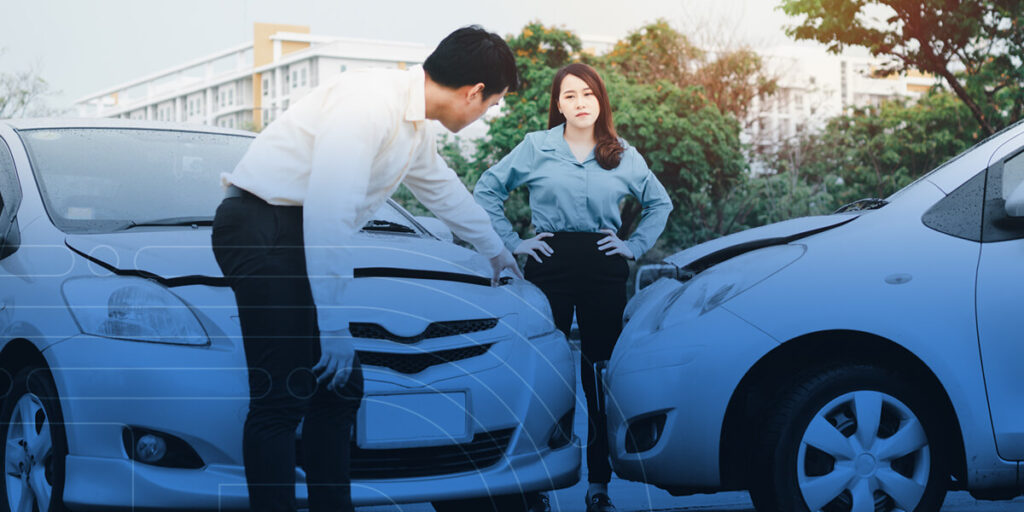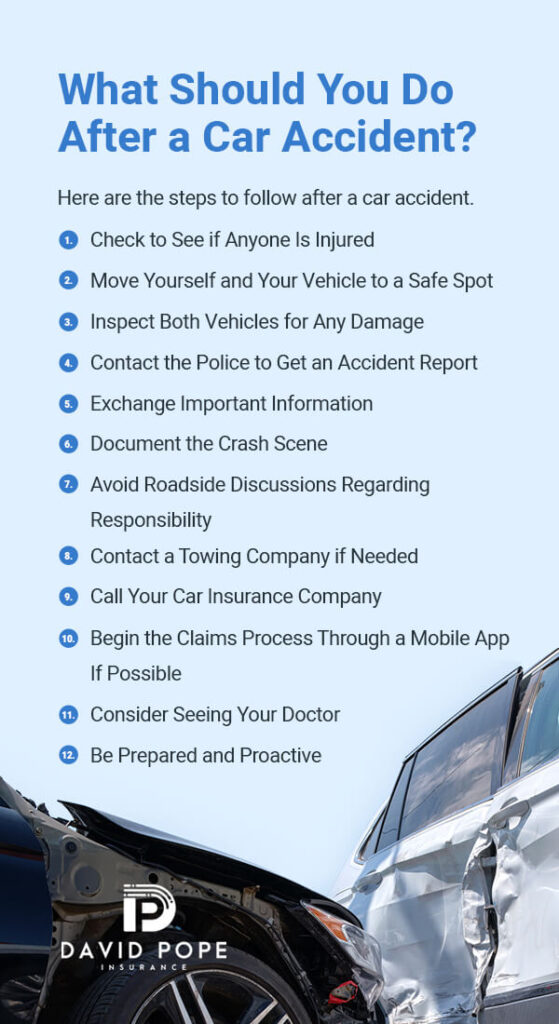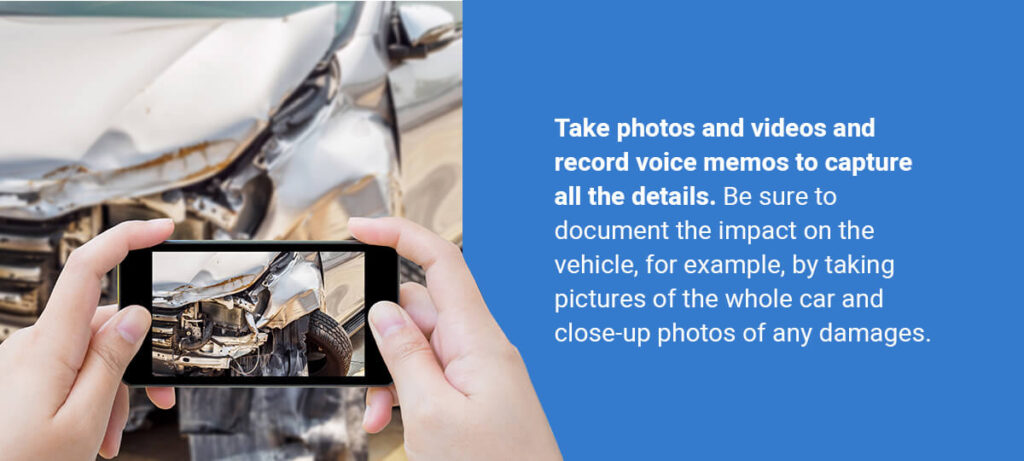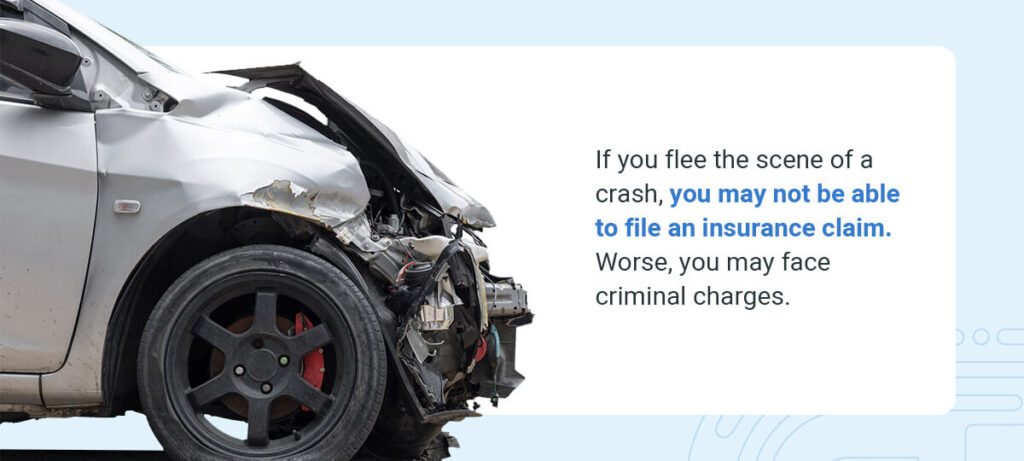
If you’ve been involved in a car accident, you aren’t alone — hundreds of car crashes occur in the United States every year. Being involved in even a minor crash can be a scary and overwhelming experience, but you can gain some peace of mind by understanding what to do when you’re in an accident. The last thing you want after an accident is to be scrambling to figure out what to do next.
While we hope you are never involved in an accident, we understand that car crashes are common, and we want to help you be prepared with this step-by-step guide. We will also cover what not to do, what to expect after you file a claim and how you can avoid accidents in the future.

If a car accident occurs, knowing what steps to take in advance can help you remain calm, stay safe and successfully file a claim with your auto insurance provider. Here are the steps to follow after a car accident.
One of the first steps to take after a crash is to check whether anyone is injured. After an accident, your first and top priority is safety. Check yourself for injuries first, then check your passengers for any visible injuries. Even if the accident is minor, injuries can still occur, so remain calm and examine everyone involved for injuries. If you are seriously injured, try to wait for help to get to you before moving.
Next, move yourself and your vehicle out of the road and to a safe spot. If you can, pull over to the shoulder so your car is not obstructing the path of approaching vehicles. Turn on your hazard lights to ensure other drivers can see you. If you cannot move your car due to severe injuries or damage, get yourself and your passengers to a safe spot out of the road but stay at the scene of the crash.
If you have an emergency kit that includes reflective triangles or flares, use them to slow and direct traffic around the scene of the accident. Even if you believe you aren’t injured, be careful when moving, especially if the crash occurred on a busy street or highway, as this location could put you in further danger.
After you ensure everyone involved in the accident is in a safe place and your vehicles have been moved out of the roadway, you can assess the cars for damage. Take pictures to capture the damage each vehicle sustained. If the cars haven’t been moved, be sure to take photos that show their position. If you cannot take photos, you may want to draw a diagram showing how the crash took place while it’s fresh in your memory.
Next, you’ll want to contact the police to let them know about the accident and get an accident report. Though you may not need to call law enforcement if the accident is very minor and there are no injuries or damages, you should always call about a serious crash. You can still report a minor accident, though the police may not arrive at the scene. Some police departments use online reporting for minor accidents rather than dedicating resources to the scene.
After you report a serious accident, police will write an accident report, which you can later request a copy of when filing your car insurance claim. If law enforcement doesn’t arrive at the scene, request a copy of your accident report from the insurance adjuster handling your claim or the police department.
Additionally, anyone who is injured should receive medical assistance. Paramedics may arrive after you call to report the accident and give emergency medical service.
Be sure to swap important information with the other driver. The laws that determine what information you should exchange vary by state. At the least, you should exchange your names and insurance information. Additionally, you may want to request more useful information from the other driver, any witnesses and law enforcement, such as:
Take photos of documents, such as driver’s license numbers. You can use a pen and paper to make notes if you don’t have a phone with a camera. If you notice that the driver’s name and the name on the insurance documents or the car’s registration don’t match, find out this person’s relationship to the vehicle’s owner. Remember that you do not need to share your coverage limits or Social Security number.

If you have a smartphone, document the scene of the accident as much as possible. Take photos and videos and record voice memos to capture all the details. Be sure to document the impact on the vehicle, for example, by taking pictures of the whole car and close-up photos of any damages. Take pictures and videos of the entire scene, including property damage and skid marks.
Note the direction the vehicles were heading before and during the accident, along with street names. Be sure to record the time and date of the accident. You also want to capture the position of the vehicles relative to the road. This information will help the insurance adjuster re-create the crash after you make your claim. With a voice memo, you can dictate exactly what happened while the incident and the details are fresh, including information regarding visibility and weather conditions. You may also want to draw a diagram of the accident scene.
Regardless of who or what you believe to be at fault for the accident, avoid discussing responsibility for the accident with the other driver. For example, if you are rear-ended and the other driver claims that the wet road prevented them from braking in time, avoid arguing and accusing them of reckless or negligent driving. Everyone’s emotions may be running high after a crash, so try to stay calm and trust your instincts. If you believe the driver may be aggressive or impaired, stay in your vehicle and contact law enforcement to handle the situation.
You may need to contact a towing company if your vehicle has sustained major damage. Your car may need repairs before it’s safe to drive again, so if you have roadside assistance through your insurance or a motor club membership, be sure to call. Some car manufacturers may also offer driver assistance programs. In some circumstances, law enforcement may call the towing company. When the tow truck shows up, verify its credentials and record all contact information to ensure it’s reputable.
Even if the other driver tries to negotiate a cash deal, you should notify your car insurance provider about the accident to avoid liability for the damages. For example, say your insurance company determines that your car is a total loss, and the other driver has little or no insurance coverage. In that case, you’ll need to rely on your insurance provider for coverage, especially if you have personal injury protection (PIP) or auto medical coverage.
If you’re unsure of the best way to proceed, you can reach out to your insurance claims professional. They can help you understand your options. For instance, if you are deemed not to be at fault for the accident, your insurer may offer a liability waiver so you can skip paying the deductible.
Some insurance companies offer virtual tools like mobile phone apps that you can use to initiate the claims process. You can call your insurer’s toll-free number for instructions or review your proof of insurance card. Your insurer may request a lot of information regarding the accident and may prompt you to use a remote inspection tool with your phone.
Other than documenting accident details, an insurance company may arrange for a rental car, send a tow truck or provide other roadside assistance via this app. After you report the accident, stay in touch with your insurer and keep your relevant documents organized while working with your insurance adjuster throughout the claims process.
Even if you don’t believe you’re injured, injuries may only become apparent after some time has passed. Major and minor accidents can cause serious spinal or head injuries, so be sure to see your doctor if you notice any unusual symptoms or pain. Typically, injuries resulting from a car accident are covered in your claim, so you should document any physical harm you experience due to the crash. A visit to the doctor and a medical report can help support your claim.
By being prepared and proactive, you can more easily stay calm after a crash and navigate the situation smoothly. Download your insurer’s forms or app that can guide you through the car insurance claims process. Keep your proof of insurance card, registration and a checklist of items to remember at an accident scene in a designated spot in your vehicle. By keeping a checklist on hand, you can navigate the process successfully.
Now that you know what to do after a car accident, you may also want to know what not to do. These are some things not to do after a car accident:

Auto insurance protects you financially in the event of a car accident, so when an accident occurs, file an insurance claim with your auto insurance company. You can expect the following steps in the claims process:
After being involved in an accident, you may be more determined than ever to prevent auto accidents in the future. Follow the tips below to avoid future accidents:
David Pope Insurance is a family-owned insurance agency with two decades of experience in this industry. We can help you determine which type of auto insurance policy you need. To ensure you get the policy for your car that provides the exact coverage you need, we’ll work with you and your budget.
Along with auto insurance, we provide home insurance, life insurance and commercial insurance. If you live or run a business in Missouri, Kansas, Arkansas, Tennessee, Nebraska, Illinois, Colorado or Iowa, you need an insurance agent who can customize an auto insurance policy to your needs.
Whether you have been in a car accident before or are a new driver, you deserve auto insurance that gives you the protection you need. Contact us at David Pope Insurance to learn more about what happens after a car accident or request a custom quote.